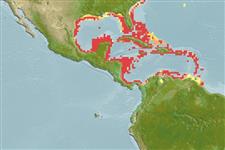>
Tetraodontiformes (Puffers and filefishes) >
Tetraodontidae (Puffers) > Canthigasterinae
Etymology: Canthigaster: Greek, kanthos = the outer or inner corner of the eye, where the lids meet, 1646 + Greek, gaster = stomach (Ref. 45335).
More on author: Bloch.
Environment: milieu / climate zone / depth range / distribution range
Ecologia
marinhas associadas(os) a recifes; intervalo de profundidade 1 - 40 m (Ref. 43205). Tropical; 34°N - 8°N, 98°W - 59°W
Western Central Atlantic: South Carolina, USA and Bermuda to Tobago and the Lesser Antilles. All Canthigaster specimens so far recorded from Madeira belong to Canthigaster capistrata (Ref. 43205).
Tamanho / Peso / Idade
Maturity: Lm ? range ? - ? cm
Max length : 12.0 cm TL macho/indeterminado; (Ref. 26340)
Espinhos dorsais (total) : 0; Raios dorsais (total) : 10 - 11; Espinhos anais: 0; Raios anais : 9. Distinguished from all other Atlantic species by a short upper dark longitudinal stripe, presence of few spots on flank and dorsum, and absence of a conspicuous (larger than eye) spot on the dorsum. The upper dark longitudinal stripe extends from caudal-fin dorsal margin to the vertical through dorsal-fin base. Although a horizontal line of dark spots extends anterior to the anterior portion of the horizontal dark stripe in some specimens, and sometimes even surpasses the dorsal fin base, this line of spots never forms a continuous stripe. Also distinguished by the absence of vertically oriented bars on the caudal fin and by the presence of bars on the snout (Ref. 43205).
Inhabits reefs and marginal habitats such as seagrass beds (Ref. 43205). Diet consists of seagrass, sponges, crabs and other crustaceans, mollusks, polychaete worms, sea urchins, starfishes, hydroids and algae (Ref. 13442). Monogamous (Ref. 52884).
Ciclo de vida ou comportamento de acasalamento
Maturidade | Reprodução | Desova | Ovos | Fecundidade | Larvas
Oviparous (Ref. 205). No parental care according to Ref. 38836.
Moura, R.L. and R.M.C. Castro, 2002. Revision of Atlantic sharpnose pufferfishes (Tetraodontiformes: Tetraodontidae: Canthigaster), with description of three new species. Proc. Biol. Soc. Wash. 115(1):32-50. (Ref. 43205)
Status na Lista Vermelha da UICN (Ref. 130435: Version 2024-1)
Ameaça para os humanos
Harmless
Uso pelos humanos
Pescarias: espécies comerciais; Aquário: Espécies comerciais
Ferramentas
Relatórios especiais
Baixar XML
Fontes da internet
Estimates based on models
Preferred temperature (Ref.
123201): 23.6 - 28, mean 26.4 °C (based on 220 cells).
Índice de diversidade filogenética (Ref.
82804): PD
50 = 0.5000 [Uniqueness, from 0.5 = low to 2.0 = high].
Bayesian length-weight: a=0.03631 (0.01554 - 0.08482), b=2.88 (2.69 - 3.07), in cm total length, based on LWR estimates for this Genus-body shape (Ref.
93245).
Nível Trófico (Ref.
69278): 3.3 ±0.1 se; based on diet studies.
Resiliência (Ref.
120179): Elevada, tempo mínimo de duplicação da população menor que 15 meses (Preliminary K or Fecundity.).
Fishing Vulnerability (Ref.
59153): Low vulnerability (10 of 100).
Nutrients (Ref.
124155): Calcium = 102 [47, 253] mg/100g; Iron = 0.966 [0.474, 2.280] mg/100g; Protein = 18.2 [16.0, 20.4] %; Omega3 = 0.133 [0.065, 0.262] g/100g; Selenium = 35.1 [17.1, 79.4] μg/100g; VitaminA = 52.6 [14.7, 200.9] μg/100g; Zinc = 1.59 [1.01, 2.41] mg/100g (wet weight);
